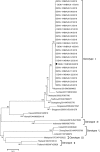Incidence dynamics and investigation of key interventions in a dengue outbreak in Ningbo City, China
- PMID: 31415559
- PMCID: PMC6711548
- DOI: 10.1371/journal.pntd.0007659
Incidence dynamics and investigation of key interventions in a dengue outbreak in Ningbo City, China
Abstract
Background: The reported incidence of dengue fever increased dramatically in recent years in China. This study aimed to investigate and to assess the effectiveness of intervention implemented in a dengue outbreak in Ningbo City, Zhejiang Province, China.
Methods: Data of a dengue outbreak were collected in Ningbo City in China by a field epidemiological survey according to a strict protocol and case definition. Serum specimens of all cases were collected for diagnosis and the virological characteristics were detected by using polymerase chain reaction (PCR) and gene sequencing. Vector surveillance was implemented during the outbreak to collect the larva and adult mosquito densities to calculate the Breteau Index (BI) and human biting rate (HBR), respectively. Data of monthly BI and light-trap density in 2018 were built to calculate the seasonality of the vector. A transmission mathematical model was developed to dynamic the incidence of the disease. The parameters of the model were estimated by the data of the outbreak and vector surveillance data in 2018. The effectiveness of the interventions implemented during the outbreak was assessed by the data and the modelling.
Results: From 11 August to 8 September, 2018, a dengue outbreak was reported with 27 confirmed cases in a population of 5536-people community (community A) of Ningbo City. Whole E gene sequences were obtained from 24 cases and were confirmed as dengue virus type 1 (DENV-1). The transmission source of the outbreak was origin from community B where a dengue case having the same E gene sequence was onset on 30 July. Aedes albopictus was the only vector species in the area. The value of BI and HBR was 57.5 and 12 per person per hour respectively on 18 August, 2018 and decreased dramatically after interventions. The transmission model fitted well (χ2 = 6.324, P = 0.388) with the reported cases data. With no intervention, the total simulated number of the cases would be 1728 with a total attack rate (TAR) of 31.21% (95%CI: 29.99%- 32.43%). Case isolation and larva control (LC) have almost the same TAR and duration of outbreak (DO) as no intervention. Different levels of reducing HBR (rHBR) had different effectiveness with TARs ranging from 1.05% to 31.21% and DOs ranging from 27 days to 102 days. Adult vector control (AVC) had a very low TAR and DO. "LC+AVC" had a similar TAR and DO as that of AVC. "rHBR100%+LC", "rHBR100%+AVC", "rHBR100%+LC+AVC" and "rHBR100%+LC+AVC+Iso" had the same effectiveness.
Conclusions: Without intervention, DENV-1 could be transmitted rapidly within a short period of time and leads to high attack rate in community in China. AVC or rHBR should be recommended as primary interventions to control rapid transmission of the dengue virus at the early stage of an outbreak.
Conflict of interest statement
The authors have declared that no competing interests exist.
Figures







Similar articles
-
The dengue preface to endemic in mainland China: the historical largest outbreak by Aedes albopictus in Guangzhou, 2014.Infect Dis Poverty. 2017 Sep 22;6(1):148. doi: 10.1186/s40249-017-0352-9. Infect Dis Poverty. 2017. PMID: 28934991 Free PMC article.
-
Dengue fever transmission between a construction site and its surrounding communities in China.Parasit Vectors. 2021 Jan 6;14(1):22. doi: 10.1186/s13071-020-04463-x. Parasit Vectors. 2021. PMID: 33407778 Free PMC article.
-
Assessing Aedes mosquito larval indicators, dengue virus infection rates, and risk factors in Khyber Pakhtunkhwa: Insights for improved vector control strategies.PLoS Negl Trop Dis. 2025 Jul 22;19(7):e0013252. doi: 10.1371/journal.pntd.0013252. eCollection 2025 Jul. PLoS Negl Trop Dis. 2025. PMID: 40694582 Free PMC article.
-
Dengue vector control in high-income, city settings: A scoping review of approaches and methods.PLoS Negl Trop Dis. 2024 Apr 17;18(4):e0012081. doi: 10.1371/journal.pntd.0012081. eCollection 2024 Apr. PLoS Negl Trop Dis. 2024. PMID: 38630673 Free PMC article.
-
The dengue situation in Africa.Paediatr Int Child Health. 2012 May;32 Suppl 1(s1):18-21. doi: 10.1179/2046904712Z.00000000048. Paediatr Int Child Health. 2012. PMID: 22668445 Free PMC article. Review.
Cited by
-
A Review of the Surveillance Techniques for Aedes albopictus.Am J Trop Med Hyg. 2022 Oct 31;108(2):245-251. doi: 10.4269/ajtmh.20-0781. Print 2023 Feb 1. Am J Trop Med Hyg. 2022. PMID: 36315996 Free PMC article. Review.
-
Epidemiological Characteristics and the Dynamic Transmission Model of Dengue Fever in Zhanjiang City, Guangdong Province in 2018.Trop Med Infect Dis. 2022 Aug 25;7(9):209. doi: 10.3390/tropicalmed7090209. Trop Med Infect Dis. 2022. PMID: 36136620 Free PMC article.
-
The effectiveness of early start of Grade III response to dengue in Guangzhou, China: A population-based interrupted time-series study.PLoS Negl Trop Dis. 2020 Aug 7;14(8):e0008541. doi: 10.1371/journal.pntd.0008541. eCollection 2020 Aug. PLoS Negl Trop Dis. 2020. PMID: 32764758 Free PMC article.
-
Computing R 0 of dynamic models by a definition-based method.Infect Dis Model. 2022 May 24;7(2):196-210. doi: 10.1016/j.idm.2022.05.004. eCollection 2022 Jun. Infect Dis Model. 2022. PMID: 35702140 Free PMC article.
-
A five-compartment model of age-specific transmissibility of SARS-CoV-2.Infect Dis Poverty. 2020 Aug 26;9(1):117. doi: 10.1186/s40249-020-00735-x. Infect Dis Poverty. 2020. PMID: 32843094 Free PMC article.
References
Publication types
MeSH terms
LinkOut - more resources
Full Text Sources
Medical
Miscellaneous

